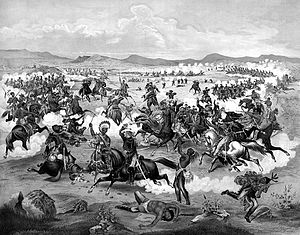| Sioux Wars | |||||||
|---|---|---|---|---|---|---|---|
| Part of the American Indian Wars | |||||||
 "Custer's Last Stand" during the Battle of Little Bighorn in 1876 on the Crow Indian Reservation.[2][3][4][5] | |||||||
| |||||||
| Belligerents | |||||||
|
Allies: |
Allies: | ||||||
| Commanders and leaders | |||||||
|
Washakie (Shoshone) Plenty Coups (Crow)[7] Alligator-Stands-Up (Crow)[8] |
Little Crow Red Cloud Crazy Horse † Sitting Bull Black Kettle † Spotted Tail | ||||||
The Sioux Wars were a series of conflicts between the United States and various subgroups of the Sioux people which occurred in the later half of the 19th century. The earliest conflict came in 1854 when a fight broke out at Fort Laramie in Wyoming, when Sioux warriors killed 31 American soldiers in the Grattan Massacre, and the final came in 1890 during the Ghost Dance War.
- ^ Libby, Orin G. (1920): The Arikara Narrative. Bismarck.
- ^ Kappler, Joseph C. (1904): Indian Affairs. Laws and Treaties. Vol. 2. pp. 1008–1011: Treaty with the Crows, May 7, 1868.
- ^ Dunlay, Thomas W. (1982). Wolves for the Blue Soldiers. Indian Scouts and Auxiliaries with the United States Army, 1860–90. Lincoln and London. p. 113.
- ^ Hoxie, Frederick E. (1995): Parading Through History. The Making of the Crow Nation in America, 1805–1935. Cambridge. p. 108 and map p. 99.
- ^ Medicine Crow, Joseph (1992): From the Heart of the Crow Country. The Crow Indians' Own Stories. New York. Map facing p. xxi.
- ^ Kappler, Joseph C. (1904): Indian Affairs. Laws and Treaties. Vol. 2. p. 595.
- ^ "The Battle of the Little Bighorn and the Great Sioux War (1876)". June 16, 2019.
- ^ Linderman, Frank B. (1962): Plenty Coups. Chief of the Crows. Lincoln and London. p. 155.